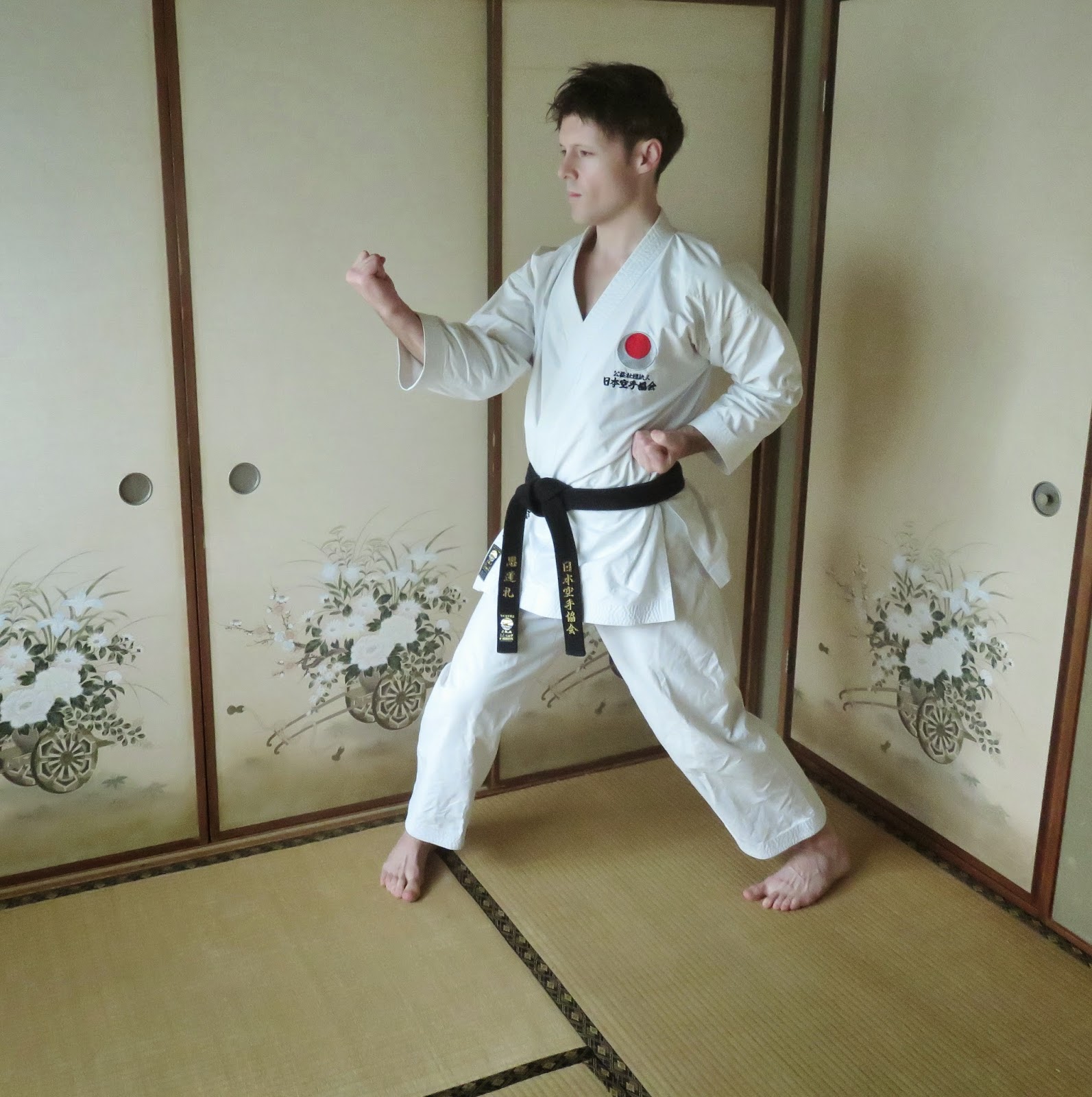 |
| A photo of my training in the early days of this website. |
One of my policies,
when I write articles on this blog, is “…when I don’t train I don’t write nor post”.
My mentality (and not at all a criticism of others) is that “When I don’t
train, I have no `right to write’ about karate”. Furthermore, I also believe doing so takes away the kokoro that comes out of this site, which has made it so popular around the world. Unambiguously, in many
ways, I suppose this is utter nonsense; nevertheless, I do intrinsically and wholeheartedly believe that when it
comes to Karate-Do, training takes precedence over every other aspect. Thinking and writing have their place, but can never replace the hard yards on the dojo floor. I’ve talked
about this much before—in past posts—but here I am posting today; indeed and understatedly,
without training for the first time in many years.
Anyway, today,
I was diagnosed with serious pneumonia (39.6 Degree Celsius fever) and told
that I must either be admitted to hospital, or go home and strictly stay inbed.
I decided to come home, as I’m not contagious (safe for our new-born baby Mia,
and Mizuho).
That being
said, the doctor told me firmly “NO WORK, NO KARATE BERTEL SAN: FOR AT LEAST FIVE DAYS!”
So, here I am, hypocritically breaking my own rules… Perhaps ironically, I have
plenty to do here, study Japanese (desperately need to do more of that), read
books, you name it,... Yet, it is really is strange not to teach nor train karate
daily… And today is only my first day!!! Oh my…
You might
think I’m implying I can’t relax, but that is not true either… Give me a cold beverage
and good company; a walk in nature; or, especially at present, time with my wife
and daughter, and I am more than relaxed.
So what am I
writing about??? Basically, ROUTINES. I couldn’t work out my consistency with
karate for so many years. I was really asking myself, and of course being asked
by friends and family, “HOW DO YOU KEEP GOING?” I am not bragging when I say this—and
you will see why—after I explain routines more specifically.
It is not my
personal determination or mind-power that keeps me going. I can’t credit those attributes
to myself, insofar as my daily karate training goes; instead, it is that karate
training is in `my daily routine’—irrespective of how busy I get in life.
If there is
not enough time for karate, I make the time. If that means getting up a lot
earlier to self-train etc., that’s exactly what I have to do.
I never jeopardise
other areas of my life for karate, especially family. Instead, like water,
karate training flows into the gaps of my life and fills them idealistically.
Perhaps there is some level of determination involved; but, more
importantly, I have a power which transcends my personal weaknesses (especially
that inherent lazy streak, which we all have).
Ewwieeee, so
André has a power… Well, no! As
mentioned above, it is primarily routine. Let’s compare daily karate training to
the simple action of brushing our teeth. We don’t stop brushing our teeth two-three
times per day because of any factor (at least I hope that no one who reads this
does…). Rather we brush on a daily basis to avoid cavities, look as nice as
possible, and not `submit the world around us to extremely bad breathe’. What I
am trying to say is that karate is simply a routine to me, more so than my effort: otherwise `lazy bones' would certainly win!
MY SECRET—KARATE IS CONTROLLED BY MY ROUTINE: If I am having a great day, and all
is super, fine, and yes, even dandy—I still train. If I am feeling tired, glum, frustrated,
or anything else—yes, I still train. What I’m trying to say here (and have indeed stated numerous times in
the past) is that “Training is not controlled by my emotions: nor love or periodic
dislike for karate—which has occurred consistently over the years; instead, it
is a part of me. This makes keeping up training `NO EFFORT’ because it is
simply what you do. It is primarily cerebral as opposed to emotionally driven. The bonus,
not the main point, is what karate does for my body and mind (irrespective of
my day). Needless to say, these points make us happy.
A special message for those who competed at the 13th Funakoshi Gichin Cup World Karate Championships. Firstly,
congratulations!!! Secondly, the fire is burning hot now, but naturally it will cool. This is a wonderful window of opportunity to routinize your karate, so that your training moves forward consistently from now. The excitement may waver for a little while, but again, don't let this influence/lessen your training. A special thanks to Pinto Karate Dojo:
http://pintokaratedojo.com/ for streaming the World Karate-Do Championships live. Also apologies to
Lutie van
den Berg Sensei and Naka Tatsuya Sensei for being unable to meet with you tomorrow night due to my illness. Of course, I am very disappointed about this.
I’ll wrap now… I hope
this little article offers you something. At the very least, if you are a
karateka, keep going to the dojo; and, make karate-do your routine: irrespective
of how many days a week you can get to the dojo (and especially irrespective of
your emotions, which are all too often hindrances to peoples life achievements
and, overall, their joy). If you do
this, you will gain the most from your training and will routinely continue;
moreover, should you choose to do so, you may well continue benefiting Karate-Do
until your old age.
Kindest regards from my
Japanese futon, André
 © André Bertel. Aso-shi, Kumamoto.
Japan (2014).
© André Bertel. Aso-shi, Kumamoto.
Japan (2014).
.%2B2.jpg)
.JPG)
.JPG)

.png)
.png)
.png)
.png)





.JPG)
.JPG)

.png&container=blogger&gadget=a&rewriteMime=image%2F*)






.jpg)
.jpg)

















